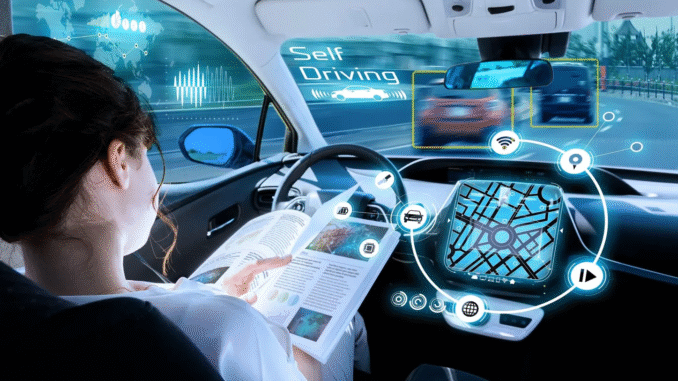
The Future of Self-Driving Cars: What You Need to Know
The automotive industry is undergoing a revolutionary transformation, and self-driving cars—also known as autonomous vehicles—are at the forefront of this change. Once the stuff of science fiction, autonomous vehicles are now a reality in development and testing across the globe. With major tech companies and automakers investing billions into this technology, it’s clear that the future of self-driving cars is not just approaching—it’s already here.
In this article, we explore the current state, future possibilities, challenges, and what you need to know about self-driving cars in 2025 and beyond.
What Are Self-Driving Cars?
Self-driving cars are vehicles equipped with technology that allows them to navigate and operate without human intervention. Using a combination of sensors, artificial intelligence (AI), cameras, radar, lidar, and machine learning algorithms, these cars can perceive their surroundings and make real-time driving decisions.
Levels of Autonomy (SAE Scale):
- Level 0: No automation. The driver controls everything.
- Level 1: Driver assistance (e.g., cruise control).
- Level 2: Partial automation (e.g., Tesla Autopilot) – the car can steer, brake, and accelerate, but a human must monitor.
- Level 3: Conditional automation – the car can handle most aspects of driving in certain conditions, but human intervention is still needed.
- Level 4: High automation – the car can drive itself without human input in most environments.
- Level 5: Full automation – the car can operate entirely on its own, in all conditions, with no steering wheel or pedals needed.
As of 2025, most vehicles with autonomous features are operating at Level 2 or 3, while Level 4 and Level 5 remain under testing and development.
Current State of Self-Driving Cars (2025)
Several companies have made significant progress toward deploying autonomous vehicles. While fully driverless cars aren’t mainstream yet, there are notable advancements:
Industry Leaders:
- Tesla: Known for its “Full Self-Driving” (FSD) beta, Tesla offers advanced driver-assist features, though the driver must remain alert.
- Waymo (by Alphabet/Google): Operates fully autonomous taxis in selected U.S. cities.
- Cruise (by General Motors): Testing driverless taxis in San Francisco and other locations.
- Aurora, Zoox, Baidu Apollo: Other players leading autonomous research and pilot programs.
Use Cases in 2025:
- Ride-hailing services in select urban areas
- Autonomous delivery vehicles
- Public shuttles in closed environments (e.g., airports, campuses)
- Highway autopilot systems in consumer vehicles
How Do Self-Driving Cars Work?
Self-driving cars rely on several key technologies working together:
1. Sensors and Cameras
Used to detect lane markings, traffic signs, pedestrians, vehicles, and obstacles. Radar and lidar provide 3D mapping and distance calculation.
2. Artificial Intelligence (AI)
AI processes vast amounts of real-time data to interpret surroundings, predict actions of others, and make safe driving decisions.
3. Machine Learning
Helps the car improve its decision-making over time by learning from data, simulations, and real-world experiences.
4. GPS and Mapping
High-definition maps allow the vehicle to understand its precise location and plan optimal routes.
5. Connectivity
Some vehicles use V2V (vehicle-to-vehicle) or V2X (vehicle-to-everything) communication to share data about road conditions, traffic, or nearby vehicles.
Benefits of Self-Driving Cars
The promise of autonomous vehicles lies in their potential to revolutionize transportation and improve safety, efficiency, and convenience.
1. Improved Road Safety
Human error causes over 90% of traffic accidents. Self-driving cars, if properly developed, could dramatically reduce crashes caused by distraction, fatigue, or impaired driving.
2. Increased Mobility
Autonomous vehicles can offer mobility solutions for:
- Seniors and people with disabilities
- Individuals who cannot drive
- Urban populations with limited access to public transport
3. Reduced Traffic Congestion
Self-driving cars can communicate with each other to optimize traffic flow, reduce bottlenecks, and eliminate unnecessary braking or acceleration.
4. Lower Transportation Costs
Autonomous taxis and delivery vehicles can operate 24/7 without drivers, potentially reducing costs for businesses and consumers alike.
5. Environmental Impact
Many autonomous cars are electric, contributing to a reduction in carbon emissions and helping cities meet sustainability goals.
Challenges and Concerns
Despite exciting progress, self-driving cars still face several technical, legal, and social challenges before they become widespread.
1. Safety and Reliability
Can self-driving systems consistently handle unpredictable conditions like:
- Poor weather (fog, snow, heavy rain)?
- Complex urban environments?
- Pedestrians and cyclists behaving erratically?
2. Regulation and Legal Frameworks
- Who is liable in case of an accident involving an autonomous vehicle?
- Are current traffic laws sufficient?
- How do insurance and licensing systems adapt?
Governments are still developing policies to regulate self-driving cars, and rules vary between countries and even states or cities.
3. Public Trust
Many people remain skeptical about fully autonomous vehicles, especially after well-publicized accidents. Building consumer trust is essential for mass adoption.
4. Cybersecurity Risks
Autonomous cars rely on software and connectivity, making them potential targets for hacking or data breaches.
5. Job Displacement
Widespread automation could affect industries that rely on human drivers—like trucking, delivery, and taxis—raising concerns about unemployment.
When Will Fully Autonomous Cars Be Available?
While Level 5 vehicles are being tested, they’re not expected to be available for public use on a wide scale until 2030 or later. The rollout will likely happen in phases, starting with:
- Geofenced urban areas
- Fixed-route shuttles
- Highway-only autonomous features
Experts agree that mass adoption will take time due to regulatory hurdles, public hesitancy, and the complexity of real-world driving environments.
How to Prepare for the Future of Self-Driving Cars
Whether you’re excited or cautious about the future of autonomous vehicles, it’s wise to stay informed and prepare for upcoming changes.
1. Stay Educated
Understand how your current car’s features work (like adaptive cruise control or lane-keeping assist) and how they relate to autonomous driving.
2. Explore New Vehicle Options
If you’re considering a new car, look for models with advanced driver-assistance systems (ADAS), such as:
- Automatic emergency braking
- Lane-centering technology
- Self-parking features
3. Monitor Local Regulations
Cities and states may adopt autonomous vehicle rules at different paces. Watch for pilot programs and infrastructure development in your area.
4. Adapt Your Driving Mindset
As technology progresses, driving may shift from active control to passive monitoring or even becoming a full-time passenger.
Conclusion: The Road Ahead
The future of self-driving cars is not just about the vehicles—it’s about redefining transportation itself. With the potential to save lives, reduce traffic, and increase mobility, autonomous cars could shape how we move through cities, travel long distances, and connect with others.
Yet, there are real challenges ahead. Safety, regulation, infrastructure, and social impact must be carefully managed as we transition into this new era. While you might not own a fully self-driving car in 2025, you’re likely to see them on the road, hail one in a ride-share app, or use vehicles with semi-autonomous features.
The bottom line? The road to autonomy is long and complex, but the wheels are already in motion. Whether you’re an early adopter or a cautious observer, one thing is clear: self-driving cars are coming—and they’re here to stay.

